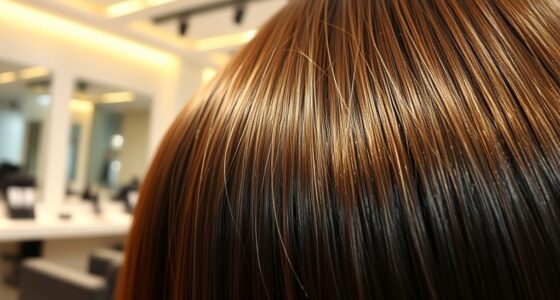To retrofit your home for wireless charging everywhere, start by choosing suitable surfaces like glass, wood, or stone that are flat and thin enough to embed chargers. Prepare your furniture or counters by carving out cavities or attaching pads flush with the surface. Conceal cables using discreet routing behind walls or furniture, and install wireless charging modules in ideal spots. Test and adjust for best performance, and if you continue exploring, you’ll discover ways to seamlessly integrate wireless power throughout your entire home.
Key Takeaways
- Select flat, non-metallic surfaces like wood, glass, or plastic within 1 inch thickness for embedding wireless chargers.
- Carve precise cavities in furniture or surfaces to flush-mount charging modules, ensuring seamless integration.
- Route cables discreetly through in-wall conduits, behind furniture, or under floors to hide power sources and maintain aesthetics.
- Test device placement and charging performance across various spots to optimize alignment and efficiency.
- Keep up with industry trends and new products to future-proof your setup and incorporate space-saving, ergonomic solutions.
Selecting Suitable Surfaces and Materials for Embedding Wireless Charging
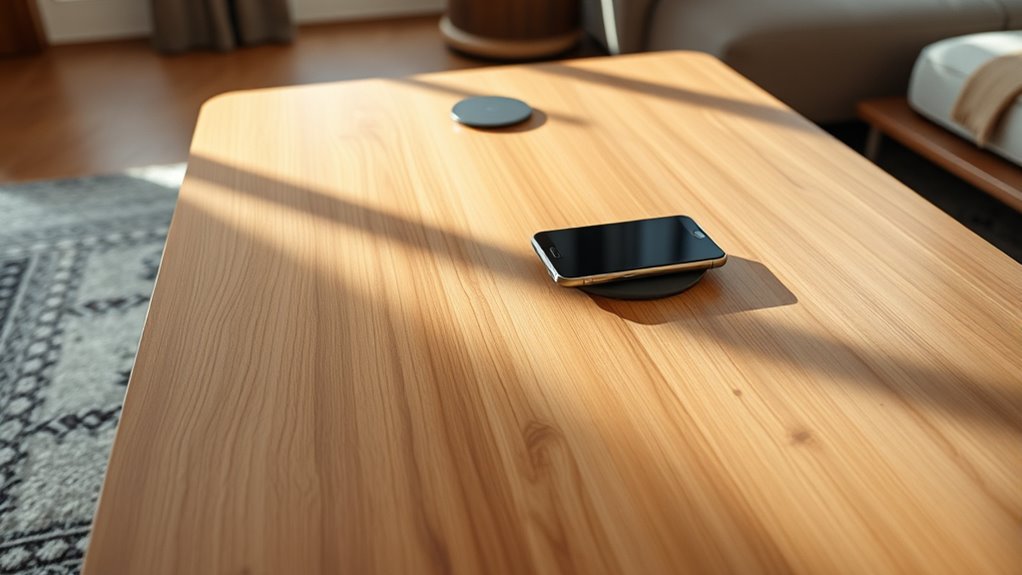
When embedding wireless charging into your home surfaces, choosing the right materials is essential for effective power transfer. Your surface should be flat, sturdy, and made of non-metallic materials like glass, plastic, wood, marble, or quartz, which don’t interfere with the charging pad’s signals. Keep in mind that the surface’s thickness should not exceed about 1 inch, as thicker surfaces can weaken wireless power transfer. Avoid embedding chargers into metal surfaces or furniture with metal components because metal blocks magnetic fields needed for inductive charging. If you plan to recess the charging pad, select durable materials that can withstand drilling or carving. Additionally, selecting appropriate shower surfaces that align with your design and functional needs can help integrate wireless charging seamlessly into your bathroom. Incorporating material properties such as thermal stability and water resistance is also beneficial for ensuring longevity and safety in various environments. It is also important to consider wireless charging effectiveness when selecting materials to ensure optimal performance. Understanding how different materials impact wireless charging efficiency can help you optimize placement and performance for your setup. Finally, consider your surface’s aesthetics and accessibility to ensure convenient device placement without obstructing its functionality or design.
Preparing Your Furniture and Countertops for Retrofit Installation

Start by choosing a surface made of wood, stone, or plastic that’s no more than an inch thick, so the wireless charger can fit snugly. Next, plan where to place the pad so it’s both accessible and visually appealing, measuring and marking carefully. Additionally, consider the color temperature adjustments to ensure the surface’s finish complements your home decor and enhances the overall aesthetic. To optimize the setup, think about incorporating mindfulness techniques that promote a calm and focused environment during installation. Incorporating website performance metrics can also help monitor how your setup impacts daily use and user interaction. Engaging in home organization systems can further streamline your space and ensure your charging stations are both functional and integrated into your overall home decor. Finally, prepare the area by carving or drilling a precise hole for a flush fit, ensuring the installation stays clean and secure.
Selecting Suitable Material
Choosing the right materials for your furniture and countertops is essential to guarantee a smooth wireless charging retrofit. Opt for non-metallic surfaces like glass, plastic, wood, marble, or quartz, which are compatible with wireless charging. To assure effective magnetic fields, keep the surface thickness within 1 inch. When planning, consider these steps:
- Select a material that won’t interfere with the wireless charger’s magnetic fields.
- Measure the surface to find the best spot for device placement, like centered or designated zones.
- Prepare tools such as a chisel or router to create a flush space for the charging stand.
- Keep the area clean and debris-free for a secure, seamless fit.
- Use appropriate headphone jacks to connect your audio devices for an enhanced multimedia experience.
- Be aware that selecting the right wireless charging technology ensures optimal performance and compatibility with various devices.
- Incorporate natural elements into your decor to promote tranquility and a calming environment, making your space more conducive to relaxation during charging sessions.
Everything you need for a sleek setup is within reach, making it easy to place your phone or Samsung Galaxy for instant power.
Planning Precise Placement
To guarantee your wireless charger fits perfectly and functions reliably, you need to carefully plan the placement on your furniture or countertops. Measure and mark the ideal spot, considering device access and aesthetics. Verify your surface material to select the right tools for carving or cutting. Use a ruler or template to locate the center of the charging zone precisely, aligning with the wireless charging pad’s specs. Allow up to 1 inch of clearance around the pad to ensure effective magnetic field transfer and avoid interference from cases or thick surfaces. Mark the outline with painter’s tape or a marker, then double-check measurements before cutting. Proper planning ensures seamless charging and a clean integration into your space. Incorporating visualization techniques can help you better imagine the final setup and optimize your placement process. Awareness of surface weight considerations can also prevent damage during installation, especially on heavier furniture.
Installing Surface-Embedded Wireless Charging Modules

Installing surface-embedded wireless charging modules involves carefully preparing your chosen flat surface to guarantee a seamless fit and ideal functionality. First, pick a surface like a table or countertop that’s no more than 1 inch thick and compatible with the wireless charging module. Next, use a measuring tool to locate the best center point, considering device placement and accessibility. Then, carve out a hole in the surface using a drill with a hole saw or a router, ensuring the cavity fits the charging module flush. Finally, secure the module inside the cavity with hot glue or similar adhesive, keeping it level and unobstructed for efficient charging. Route the power cable discreetly beneath or behind the surface, using clips or zip ties for a tidy, seamless look. Ensuring proper surface preparation is essential for optimal wireless charging performance.
Concealing Cables and Ensuring Seamless Integration
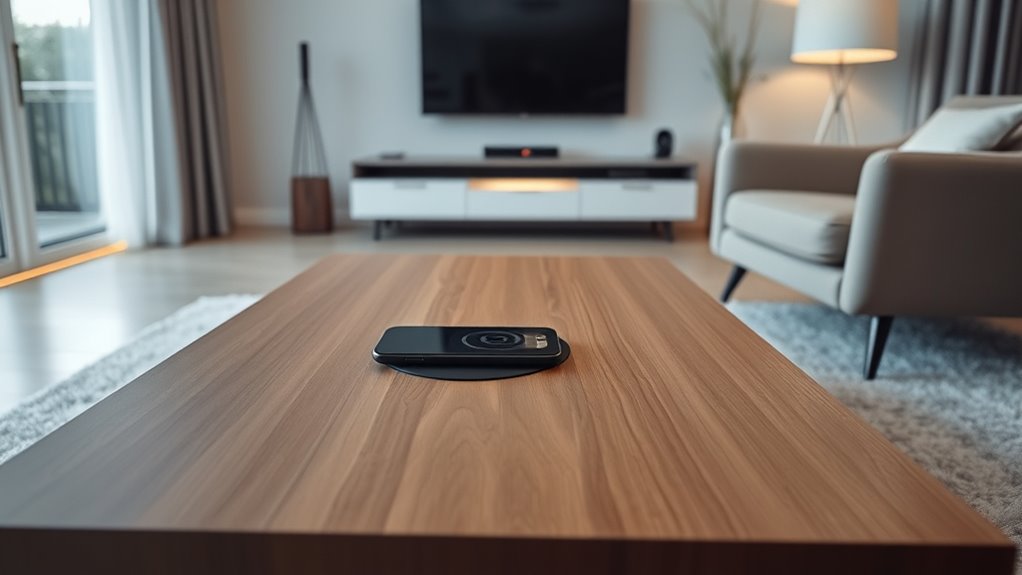
To achieve a clean, integrated look, you should consider discreet cable routing options like in-wall conduits or underfloor channels. Hiding power sources behind furniture or within walls helps eliminate clutter and maintain a seamless surface. Using surface finishes that conceal cables and incorporating subtle indicators ensures your charging areas stay tidy and unobtrusive. Additionally, employing effective communication techniques when explaining your setup to others can help prevent misunderstandings and ensure a smooth integration process. Implementing space optimization strategies can further enhance the appearance and functionality of your wireless charging setup while supporting a clutter-free environment. Incorporating ergonomic furniture can also improve comfort and accessibility in your space, making the setup both functional and inviting. Regularly monitoring your environment for interference can further enhance wireless charging efficiency and convenience. Being aware of industry trends can help you stay updated on the latest innovations and improvements in wireless power technology.
Discreet Cable Routing
Achieving a seamless look with wireless charging often depends on effective cable management. To keep cords hidden and maintain a clean space, consider these strategies:
- Use zip-ties, cable clips, or adhesive mounts to route cables along furniture legs or behind walls, keeping cords out of sight.
- Run cables under rugs, behind baseboards, or through built-in wall channels for a clutter-free appearance.
- When installing wireless pads inside furniture or countertops, hide the power cords beneath surfaces or inside cavities.
- Mark charging zones with small decals, tape, or engraved indicators to guide device placement and minimize visible cables.
- Incorporate self-watering planters into your decor to add greenery while subtly hiding cables and creating a natural concealment for wiring.
- Opt for low-profile cable solutions, such as braided sleeving or adhesive cable sleeves, which help bundle multiple cords and create a tidy, unobtrusive setup that blends seamlessly into your home.
Hidden Power Sources
Concealing power sources is key to maintaining a sleek and clutter-free look in your home. You can hide cables by routing them through wall cavities, under baseboards, or within furniture, keeping wires out of sight. Embedding wireless charging pads beneath surfaces like countertops or desks allows devices to charge seamlessly without visible cords or adapters. Cable management systems such as zip ties, clips, or conduits help organize and hide wires along walls and furniture edges, reducing clutter. Installing wireless charging surfaces or furniture with built-in charging modules creates a clean, integrated appearance. Additionally, magnetic or adhesive mounts behind furniture or within walls keep charging components hidden while remaining accessible. These strategies ensure your home maintains a polished look without sacrificing functionality.
Seamless Surface Finish
Integrating wireless charging into your surfaces requires careful planning to create a seamless look. First, carve precise holes that fit the charging pads flush with the surface, ensuring they blend in. Second, use adhesives like hot glue or epoxy to attach the pads securely underneath, keeping everything stable and hidden. Third, route power cables discreetly along the underside or behind furniture with zip-ties or clips to hide wires from view. Fourth, mark the charging zone with subtle decals, tape, or carvings to guide placement without disrupting the aesthetic. Before sealing, double-check the fit and functionality to avoid damage. With these steps, you’ll achieve a sleek, integrated look that conceals cables and maintains your surface’s clean, seamless appearance.
Testing and Optimizing Wireless Charging Performance
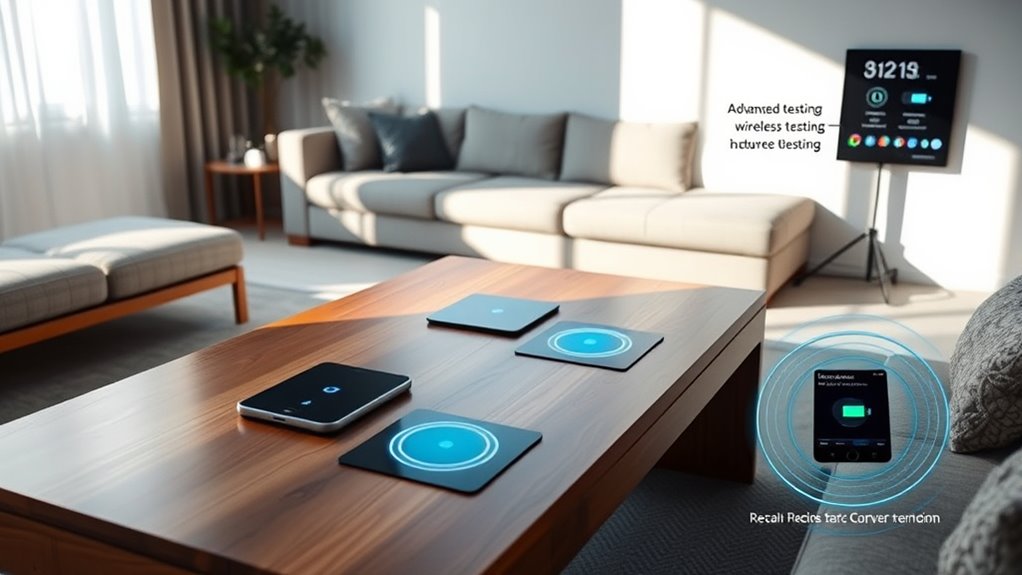
To guarantee your wireless charging setup works reliably, you need to test and enhance its performance thoroughly. Begin by placing your device in multiple positions on the charging surface to ensure consistent power transfer. Measure the charging speed and efficiency, adjusting the device’s placement to find the best spot with the strongest connection. Use a compatible power meter to monitor the wattage delivered, confirming it meets Qi standards. Test through different case thicknesses and materials to determine the maximum acceptable combination that still allows effective charging. Regularly inspect the installation for misalignments or damage that could weaken magnetic coupling. These steps help identify weak spots and ensure your setup delivers reliable, efficient wireless charging across various devices and conditions.
Expanding Wireless Charging Across Multiple Areas and Devices
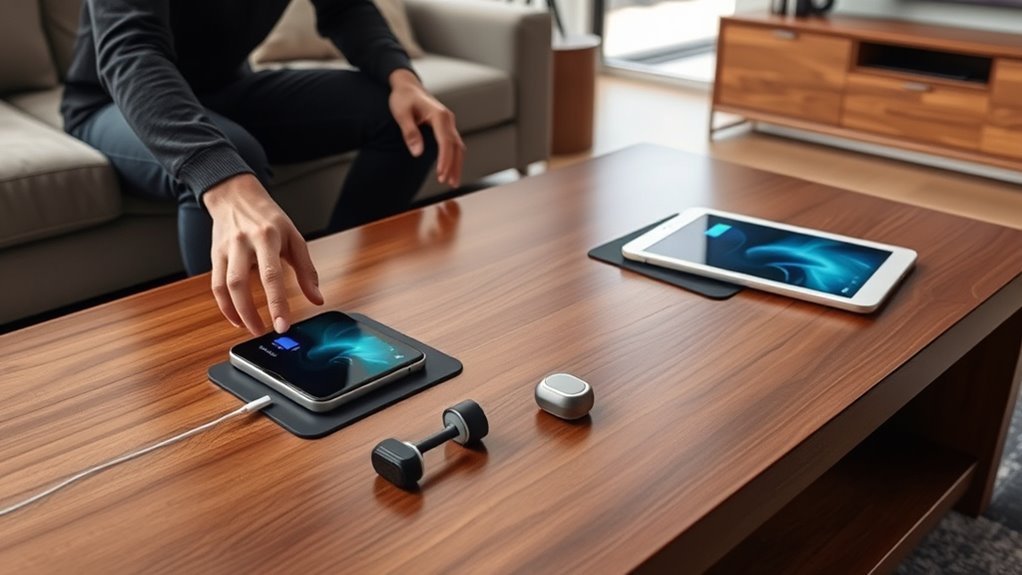
Expanding wireless charging across multiple areas and devices is a practical way to enhance convenience throughout your home. You can achieve this with minimal disruption by installing multiple Kew Labs UTS-1 units, which provide seamless coverage across surfaces and rooms. Daisy-chaining chargers with compatible adapters lets you power several devices simultaneously in different spots. For larger spaces, room-wide systems like Disney’s QSCR ensure consistent charging coverage. Additionally, embedding FreePower surfaces in key areas like the living room, kitchen, or bedroom supports charging up to three devices at once. To maximize efficiency, strategically place wireless zones where you naturally spend time, making device charging effortless without clutter or cords.
Frequently Asked Questions
How to Make Wireless Charging at Home?
To make wireless charging at home, start by installing a wireless charging pad or kit under your surface, like a table or countertop. Use appropriate tools to carve or drill a snug hole, embedding the pad flush with the surface. Secure it with adhesive, connect it to power, and hide the wiring. Mark the ideal phone placement and guarantee your device supports Qi charging for seamless, efficient power transfer.
Can Wireless Charging Go Through Wood?
You might worry that wood blocks wireless charging. Actually, wireless signals pass through wooden surfaces up to about 1 inch thick with little loss. Thinner wood, like veneer or plywood under 0.5 inches, works even better. Just make certain there’s no metal inside, as it can disrupt the signal. Position your wireless charger beneath the wood, and you’ll enjoy seamless power transfer without needing to remove or alter your furniture.
Are Qi Adapters Safe?
You might wonder if Qi adapters are safe. Rest assured, they are. Qi wireless charging technology uses low-level magnetic fields, which are considered safe for everyday exposure. Regulatory agencies like the FCC and IC test and certify these adapters to meet strict safety standards. The World Health Organization also states that the magnetic fields from Qi chargers are well below harmful levels, so using them won’t pose health risks.
How Does Freepower Work?
You ask how FreePower works. It embeds a discreet 12×8-inch wireless charger into your surface, like a countertop. When you place your device on it, overlapping coil arrays activate a subtle electromagnetic field via a wave-to-wake sensor, detecting hand movement. This triggers charging at Qi2 speeds up to 15W, supporting multiple devices simultaneously without precise placement, making your space clutter-free and effortlessly powered.
Conclusion
By thoughtfully retrofitting your home with wireless charging, you’re subtly embracing a more effortless lifestyle. With some careful planning and a few simple tweaks, you’ll enjoy the convenience of powering your devices without clutter or fuss. It’s like giving your space a gentle upgrade—making everyday moments smoother and more enjoyable. So, take your time, enjoy the process, and soon, you’ll wonder how you ever managed without this seamless tech harmony.



